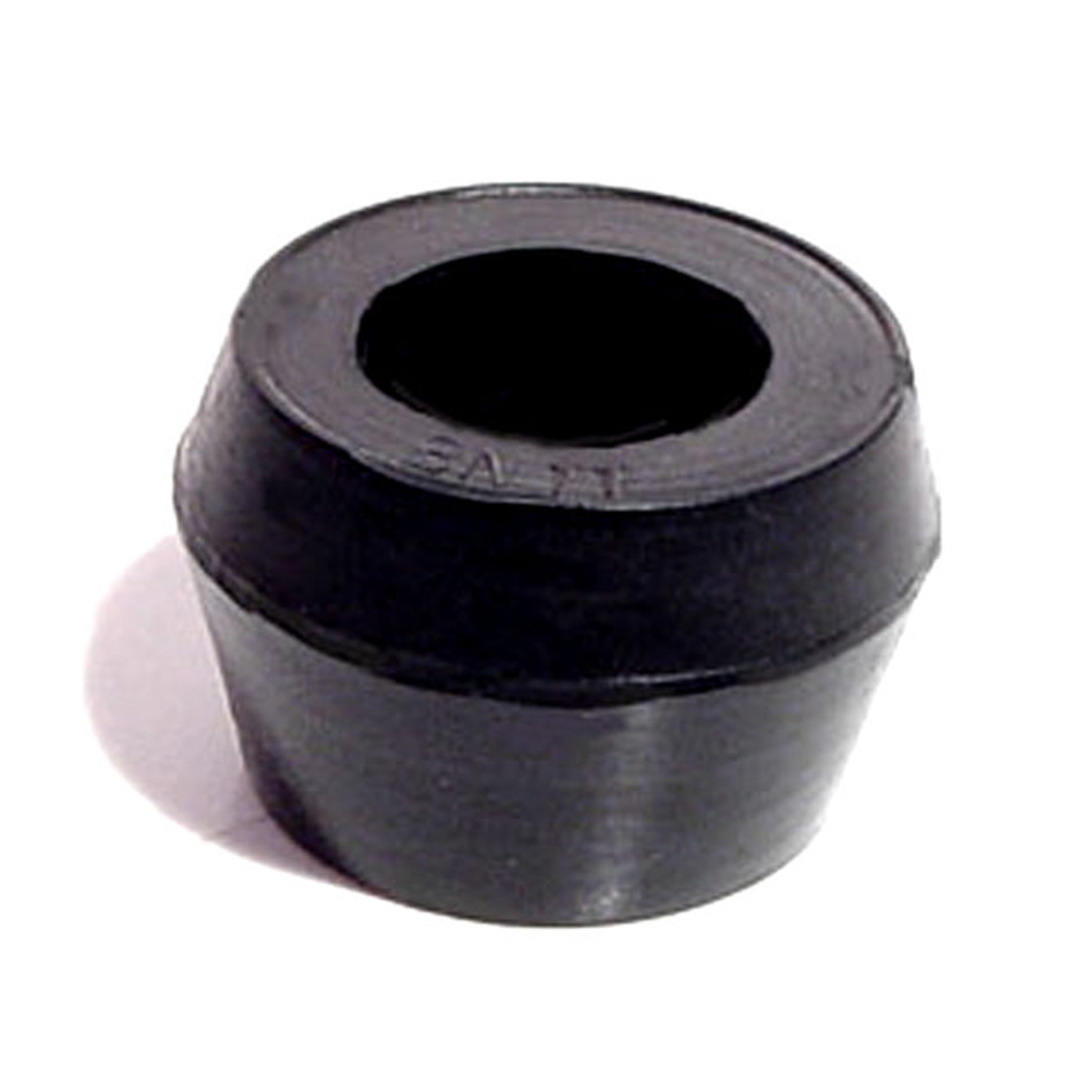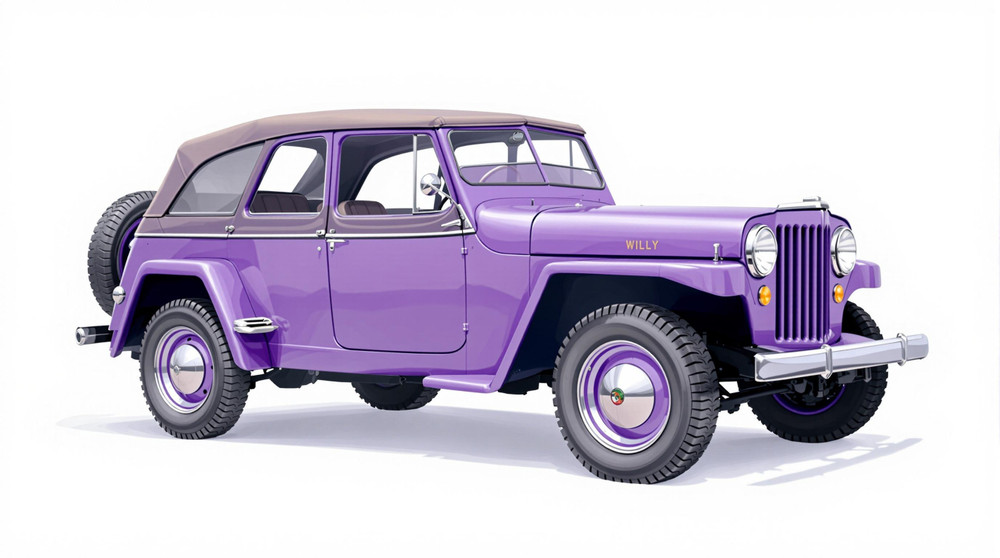Image of 1942 Jeep Willys, Note: These illustrations use artistic license and may differ from actual historical models.
Performance Metrics
Fundamental Metrics
Emotional Appeal
MMP Rating
| Engine Specifications | |
|---|---|
| Engine: | L134 Go Devil I4 |
| Displacement: | 134 cu in (2.2 L) |
| Horsepower: | 60 hp at 4000 rpm |
| Torque: | 105 lb-ft at 2000 rpm |
| Compression Ratio: | 6.48:1 |
| Ignition System: | Battery Ignition |
| Cooling System: | Liquid-cooled |
| Performance Specifications | |
| 0-60 Time: | Not available due to the vehicle's age and purpose |
| 1/4 Mile Time: | Not available due to the vehicle's age and purpose |
| Top Speed: | 65 mph |
| Transmission and Drive | |
| Drive Type: | 4WD |
| Transmission Type: | 3-speed manual |
| Fuel and Efficiency | |
| Fuel System Type: | Carburetor |
| MPG: | 15-20 mpg |
| Dimensions and Brakes | |
| Brakes: | Hydraulic drum brakes |
| Wheelbase: | 80 inches |
| Weight: | 2,293 lbs |
Note: Specifications for classic cars are given to the best of our ability, considering the limited and variant data available.
1942 Jeep Willys: The Iconic Warhorse
The 1942 Jeep Willys is not just a vehicle; it's a symbol of resilience and innovation that played a pivotal role in World War II. Born out of necessity, the Willys MB, as it was officially known, was manufactured by Willys-Overland Motors in response to the U.S. Army's demand for a light reconnaissance vehicle. This rugged and reliable machine quickly became the backbone of the Allied forces, with its versatility making it indispensable on the battlefield. A unique fact that often surprises enthusiasts is that the term "Jeep" is thought to have evolved from the phonetic pronunciation of "GP," which stands for General Purpose vehicle.
Design and Innovation
The exterior styling of the 1942 Jeep Willys was purely functional, with its flat fenders, slatted grille, and compact body designed for maximum efficiency and durability. Inside, the interior was Spartan, with bare metal surfaces and minimal comforts reflecting its utilitarian purpose. The materials used were robust to withstand harsh conditions, with canvas seats and a simple dashboard layout featuring only essential controls. Technologically, the Jeep Willys was ahead of its time with features like four-wheel drive and a powerful engine that could tackle rough terrain with ease. While color options were limited during wartime production, olive drab was the color of choice for military use. The most iconic body style is undoubtedly the open-top design with fold-down windshield, which has become synonymous with military Jeeps.
Historical Significance
The 1942 Jeep Willys didn't just influence automotive design; it revolutionized how wars were fought. Its light frame, maneuverability, and reliability set it apart from other vehicles of its era. The Jeep's ability to transport troops and equipment over rough terrain changed military tactics and has had a lasting influence on off-road vehicle design to this day.
Performance and Handling
Performance-wise, the 1942 Jeep Willys boasted a top speed of around 60 mph—a respectable figure given its purpose and time period. Acceleration was not a primary concern for a reconnaissance vehicle; however, its ability to maintain momentum over challenging landscapes was critical. Handling rough terrain came naturally to the Willys Jeep; its solid axles and leaf spring suspension absorbed bumps effectively while maintaining stability in windy conditions. Driving a Willys Jeep is an exercise in historical empathy; one can almost hear the roar of its 60-horsepower engine and feel the no-frills ride that soldiers experienced during wartime missions.
Ownership Experience
Originally intended for military use, post-war surplus saw many Jeeps repurposed as farm vehicles, off-roaders, or even daily drivers. Their maintenance is straightforward due to their simple mechanical design, making them relatively easy to repair by modern standards. Despite being built for functionality over comfort or performance, these vehicles have an undeniable charm that has attracted collectors and enthusiasts worldwide.
Fun Facts
Some interesting trivia about the 1942 Jeep Willys includes its cameo roles in numerous war films and even ownership by celebrities like Ronald Reagan. Although not designed for speed records or endurance races, its mass production during World War II—over 360,000 units—speaks volumes about its importance at that time. Common criticisms often revolve around its basic comfort levels and on-road handling compared to modern vehicles—but such comparisons overlook the historical context of this remarkable machine.
Collector's Information
Today, a well-preserved 1942 Jeep Willys can fetch anywhere from $15,000 to $30,000 or more depending on condition and originality. Rarity varies as many were produced; however, finding one in original condition can be challenging due to their age and use in harsh conditions. As historical artifacts with both military significance and cultural cachet, these vehicles have generally appreciated over time—making them not just collector's items but investments in automotive history.
Conclusion
The 1942 Jeep Willys stands as a testament to American ingenuity during one of history's most challenging periods. Its design simplicity belies the profound impact it had on both military operations and automotive engineering. For collectors or history buffs alike, owning a piece of this legacy is akin to preserving an important chapter in our collective narrative—a narrative where utility met heroism on four wheels.
1942 Jeep Willys Catalog of Parts
 1942 Jeep WILLYS Shock Absorber Grommet. 1" bottom O.D-BN 11Shock Absorber Grommet. 1" bottom O.D., 3/4" high, with 5/8" I.D. Each
1942 Jeep WILLYS Shock Absorber Grommet. 1" bottom O.D-BN 11Shock Absorber Grommet. 1" bottom O.D., 3/4" high, with 5/8" I.D. EachWhy Choose Metro?
For over 100 years, Metro Moulded Parts has been the pinnacle of quality in classic car restoration parts. Our commitment to precision and authenticity in every component ensures a perfect fit and an OEM-level appearance.
- Expert Craftsmanship & Quality: Each part is a testament to our dedication to reliability and perfection, crafted from original designs and thoroughly tested.
- Advanced Technology: We use cutting-edge techniques to create flawless, long-lasting parts that surpass others in performance.
- SuperSoft Sponge – The Ultimate Door Seal: Not only are our door seals 30% softer than competitors', but they're also guaranteed to never leak. They effectively reduce wind and road noise, enhancing your classic car's comfort and driving experience.
- Proudly American: Our parts are a product of American craftsmanship, made in the USA with a spirit of excellence and heritage.
- Unrivaled Warranty: We back our products with a 30-year industry-leading warranty, a testament to our confidence in their quality.
Join us in preserving the legacy of classic cars with parts that are crafted for perfection, not just made.

